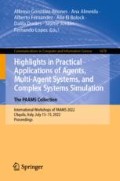Abstract
Teachers play a critical role in the education process. The importance of this role is not diminished when transitioning into Education inside Virtual Reality. With the rise of popularity in VR and remote education, the optimization of virtual teachers becomes needed. In this paper, we present a tool that provides facial animations to virtual teachers. The tool is designed to be user friendly, generic, and work across different models and facial expressions in order to serve a wide range of use cases. The tool was tested for usability and feedback was collected regarding its functionality. Our results indicate that our tool is user friendly and needed and has potential for further development and adoption.
Access this chapter
Tax calculation will be finalised at checkout
Purchases are for personal use only
References
Afifi, B.M., El Bolock, A., Alaa, M., Herbert, C., Abdennadher, S.: VRacter: investigating character-based avatar preference in education. In: De La Prieta, F., et al. (eds.) PAAMS 2020. CCIS, vol. 1233, pp. 71–82. Springer, Cham (2020). https://doi.org/10.1007/978-3-030-51999-5_6
Alhalabi, W.: Virtual reality systems enhance students’ achievements in engineering education. Behav. Inf. Technol. 35, 1–7 (2016). https://doi.org/10.1080/0144929X.2016.1212931
Brooke, J.: SUS: a retrospective. J. Usabil. Stud. 8, 29–40 (2013)
Cai, Y., Chiew, R., Nay, Z., Indhumathi, C., Huang, L.: Design and development of VR learning environments for children with ASD. Interact. Learn. Environ. 25, 1–12 (2017). https://doi.org/10.1080/10494820.2017.1282877
Coppola, N., Hiltz, S., Rotter, N.: Becoming a virtual professor: pedagogical roles and ALN, p. 10 p. (2001). https://doi.org/10.1109/HICSS.2001.926183
Darwin, C.: The expression of the emotions in man and animals (1872). https://doi.org/10.1037/10001-000
Doswell, J.: Building the virtual reality instructor (2004). https://doi.org/10.1145/1186107.1186128
Du, S., Tao, Y., Martinez, A.: Compound facial expressions of emotion. Proc. Natl. Acad. Sci. U.S.A. 111, E1454–E1462 (2014). https://doi.org/10.1073/pnas.1322355111
Ekman, P.: Darwin, deception, and facial expression. Ann. New York Acad. Sci. 1000, 205–221 (2004). https://doi.org/10.1196/annals.1280.010
Elgewely, M., Nadim, W., ElKassed, A., Yehiah, M., Talaat, M., Abdennadher, S.: Immersive construction detailing education: building information modeling (bim)-based virtual reality (VR). Open House Int. ahead-of-print (2021). https://doi.org/10.1108/OHI-02-2021-0032
Faltaous, S., el Bolock, A., Talaat, M., Abdennadher, S., Schneegaß, S.: Virtual reality for cultural competences, pp. 457–461 (2018). https://doi.org/10.1145/3282894.3289739
Haneef, M., Faisal, M.A., Alvi, A.K., Zulfiqar, M.: The role of non verbal communication in teaching practice. Sci. Int. (Lahore) 26, 513–517 (2014)
Hu-Au, E., Lee, J.: Virtual reality in education: a tool for learning in the experience age. Int. J. Innov. Educ. 4, 215–226 (2018). https://doi.org/10.1504/IJIIE.2017.10012691
Isabwe, G.M.N., Moxnes, M., Ristesund, M., Woodgate, D.: Children’s interactions within a virtual reality environment for learning chemistry. In: Andre, T. (ed.) AHFE 2017. AISC, vol. 596, pp. 221–233. Springer, Cham (2018). https://doi.org/10.1007/978-3-319-60018-5_22
Ke, F., Im, T.: Virtual-reality-based social interaction training for children with high-functioning autism. J. Educ. Res. 106, 441–461 (2013). https://doi.org/10.1080/00220671.2013.832999
Lee, H., Shvetsova, O.: The impact of VR application on student’s competency development: a comparative study of regular and VR engineering classes with similar competency scopes. Sustainability 11, 2221 (2019). https://doi.org/10.3390/su11082221
Lee, M., Spryszynski, A., Nersesian, E.: Personalizing VR educational tools for English language learners (2019)
Limniou, M., Roberts, D., Papadopoulos, N.: Full immersive virtual environment CAVETM in chemistry education. Comput. Educ. 51, 584 (2008). https://doi.org/10.1016/j.compedu.2007.06.014
Lin, M.: A study on the effect of virtual reality 3D exploratory education on students’ creativity and leadership. EURASIA J. Math. Sci. Technol. Educ. 13, 3151-3161 (2017). https://doi.org/10.12973/eurasia.2017.00709a
Parsons, S., Cobb, S.: State-of-the-art of virtual reality technologies for children on the autism spectrum. Eur. J. Spec. Needs Educ. 26, 355–366 (2011). https://doi.org/10.1080/08856257.2011.593831
Raikwar, A., et al.: CubeVR: digital affordances for architecture undergraduate education using virtual reality, pp. 1623–1626 (2019). https://doi.org/10.1109/VR.2019.8798115
Rodríguez, C.: Virtual teaching in postgraduate programmes: the importance of social collaboration in virtual communities. Proc. - Soc. Behav. Sci. 237, 1430–1438 (2017). https://doi.org/10.1016/j.sbspro.2017.02.223
Safwat, S., El Bolock, A., Alaa, M., Faltaous, S., Schneegass, S., Abdennadher, S.: The effect of student-lecturer cultural differences on engagement in learning environments - a pilot study. In: De La Prieta, F., et al. (eds.) PAAMS 2020. CCIS, vol. 1233, pp. 118–128. Springer, Cham (2020). https://doi.org/10.1007/978-3-030-51999-5_10
Schofield, J., Davidson, A.: The impact of internet use on relationships between teachers and students. Mind Cult. Act. 10, 62–79 (2003). https://doi.org/10.1207/S15327884MCA1001_06
Theonas, G., Hobbs, D., Rigas, D.: Employing virtual lecturers’ facial expressions in virtual educational environments. IJVR 7, 31–44 (2008)
Wentzel, K.: Students’ relationships with teachers as motivational contexts. In: Handbook of Motivation at School, pp. 301–322 (2009)
Author information
Authors and Affiliations
Corresponding author
Editor information
Editors and Affiliations
Rights and permissions
Copyright information
© 2022 The Author(s), under exclusive license to Springer Nature Switzerland AG
About this paper
Cite this paper
Alaa, M., Abdennadher, S. (2022). FAN-VE: A Tool for Facial Animation Generation in Virtual Reality Education. In: González-Briones, A., et al. Highlights in Practical Applications of Agents, Multi-Agent Systems, and Complex Systems Simulation. The PAAMS Collection. PAAMS 2022. Communications in Computer and Information Science, vol 1678. Springer, Cham. https://doi.org/10.1007/978-3-031-18697-4_12
Download citation
DOI: https://doi.org/10.1007/978-3-031-18697-4_12
Published:
Publisher Name: Springer, Cham
Print ISBN: 978-3-031-18696-7
Online ISBN: 978-3-031-18697-4
eBook Packages: Computer ScienceComputer Science (R0)

